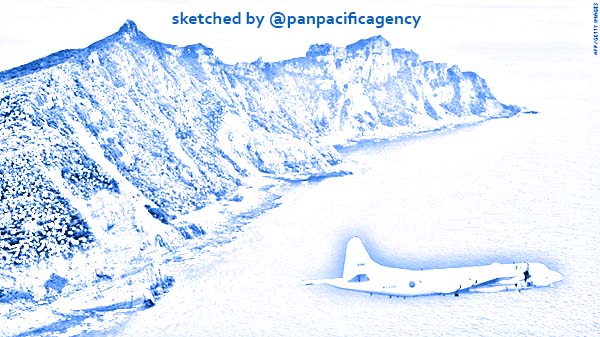Japan, US conduct joint military drills amid China’s assertiveness

A Japanese military plane flies over the Senakuku/Diaoyu islands in this file photo. Sketched by the Pan Pacific Agency.
TOKYO, Dec 7, 2020, Kyodo. Japan’s Ground Self-Defense Force and the U.S. military on Monday invited the media to view a large-scale joint drill in southwestern Japan while launching another exercise northwest of Tokyo amid China’s growing assertiveness in the East and South China seas, Kyodo News reported.
The two exercises — “Yama Sakura” (mountain cherry blossom) in Kumamoto Prefecture and “Forest Light” in Niigata and Gunma prefectures — focus on scenarios in which Japan and the United States take countermeasures against attacks on remote islands by adversaries, the Defense Ministry said.
In a ceremony Monday for the media viewing of Yama Sakura, a joint command post exercise that began Dec. 2, Lt. Gen. Ryoji Takemoto, head of the GSDF Western Army said, “For a free and open Indo-Pacific region, improving joint operational capabilities is an urgent task.”
The tabletop drill through Dec. 15 will involve some 4,000 GSDF members and about 1,000 American troops including members of units located remotely who will join the exercise online.
Held since 1982, it is one of the largest-scale exercises conducted by the GSDF and the U.S. Army.
In Forest Light, due to run through Dec. 18, the GSDF and the U.S. Marine Corps deployed CH-47 helicopters and MV-22s, which are the Marine variant of the Osprey tilt-rotor aircraft.
“We’re engaging in a variety of training in our interoperability,” Lt. Col. Neil Berry, the commanding officer of the Marines’ 3rd Battalion, 8th Regiment, told Kyodo News before the start of the drill. “We’re really working on the ability to seize and defend key maritime terrain.”
“(The drill) should give confidence to not only the Japanese Self- Defense Forces and the American Marines but all of our partners and allies in the region that we’re ready to stand shoulder to shoulder in this region against whatever adversaries pop up,” Berry said.
The exercises came after Japanese Prime Minister Yoshihide Suga and U.S. Marine Corps Commandant Gen. David Berger voiced opposition to China’s increasing assertiveness in the Indo-Pacific region in their meeting in Tokyo last month.
They shared strong concerns about Beijing’s unilateral attempts to change the status quo in the East and South China seas through force and coercive measures and agreed to maintain deterrence under the Japan-U.S. alliance.
China routinely sends official ships to waters near the Japan-administered Senkaku Islands in the East China Sea, a group of islets that Beijing also claims and calls Diaoyu. The country is also involved in territorial disputes with its neighbors in the South China Sea, building artificial islands with military infrastructure.
The semiannual Forest Light exercise applies a concept officially discussed in 2018 known as the Expeditionary Advanced Base Operations, or EABO.
Seen as developed with China in mind, the notion envisages U.S. forces maintaining a persistent forward naval presence in urgent or normal situations to counter attempts to prevent U.S. military intervention in areas of concern.